We look to our city centers for culture, nightlife, fine dining and above all, high-density urban living. Farming typically doesn't come to mind. But landscape architect David Seiter says we can and should turn to our existing infrastructure as the landscape for growing our own food. One of his latest projects, Pool Farm, is convincing evidence.
When Adam Block approached Seiter with the idea to convert the rooftop pool of his restaurant, The Press Lounge, into an upscale dining terrace and kitchen garden, Seiter was thrilled. The project combined Seiter's passions for urban infill development, gardening and rooftop landscapes in an unbeatable locale: Manhattan. The result is a stylish example of how you can grow your own food just about anywhere.
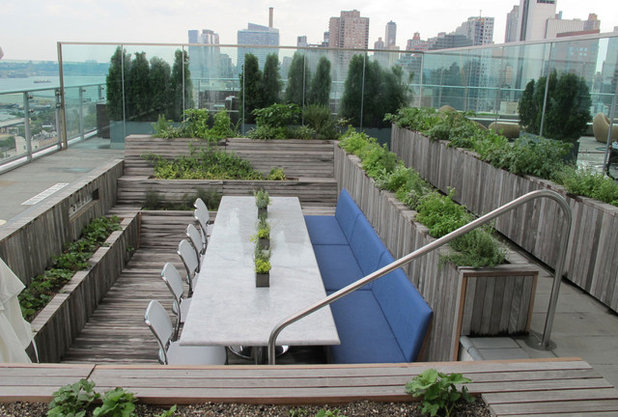
Future Green Studio
The restaurant has its own forager, and the chef favors farm-to-table sourcing. Having diners eat alongside ingredients of their meals made a lot of sense, both logistically and philosophically.
Block’s original idea for the garden was to sink the dining area into what had been a rooftop pool. Using that concept, Seiter and his team at Future Green Studio designed and fabricated a system of terraced planters. Cascading from the pool deck to the pool floor, the planters soften the transition into the lowest level while allowing easy access to the plants themselves.
Salvaged ipe decking is the primary material throughout the project. Seiter took inspiration for the wood application from the design of a sushi mat: fixed and unyielding in one direction, flexible and foldable in the other. The "mat" design rolls fluidly from the deck into the pool and planters, enclosing a dining party in an intimate space within the surrounding cityscape.
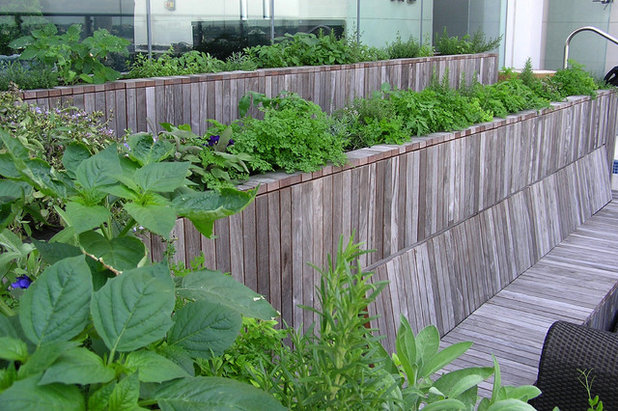
Future Green Studio
Early on, Seiter met with the chef, the forager and a rooftop farming consultant to discuss plant selection and site design. The farming consultant would continue to manage the roof, working with the staff to replace seasonal vegetables.
Seiter acknowledges that while Pool Farm is upscale and exclusive and may contribute to the restaurant's buzz more than anything, it also can inspire ideas for edible gardening in cities and suburbs everywhere.
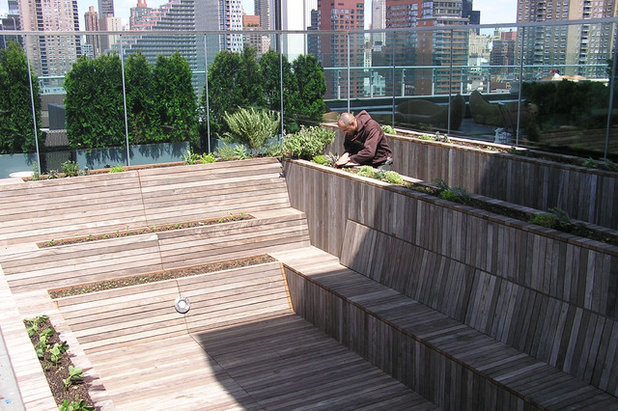
Future Green Studio
1. Repurpose or refurbish materials when you can. Construction of Pool Farm coincided with a renovation of the restaurant downstairs. After discovering a heap of scrap ipe wood leftover from the demolition, Seiter repurposed it and designed the entire project around the planks. Existing site conditions and materials influenced the design in a responsible and creative way, if not unconventional.
Take time to explore and inventory materials you already have before you head to the store. Leftovers from a recent remodel, a forgotten collection of hodgepodge pottery or even a Dumpster-dive can source your primary building materials. This saves money, produces less waste and creates an intimate connection with each component of your garden.
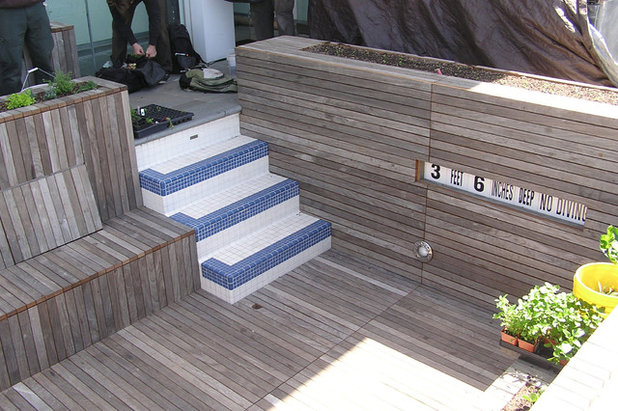
Future Green Studio
2. Work with the site, not against it. Seiter retained as much of the bones of the pool as possible, preserving the history of the site in a layering process. The pool steps remained, pool depths and handrail stayed — they even repurposed the pool lights. The sunken dining area also shelters diners from rooftop winds and created more versatility for planter design.
Don’t stress too much over design trends or what you think your garden should look like. Embrace the site and work with what’s available to you.
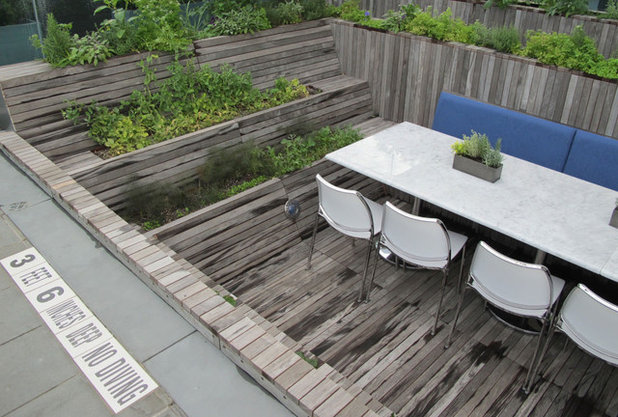
Future Green Studio
3. Solve problems creatively. Seiter terraced the planters to conceal and camouflage different sizes and depths. This allowed versatility when designing the planting plan. More substantial, long-lived herbs, such as rosemary, were given larger planters while smaller, more delicate herbs could grow in shallower planters.
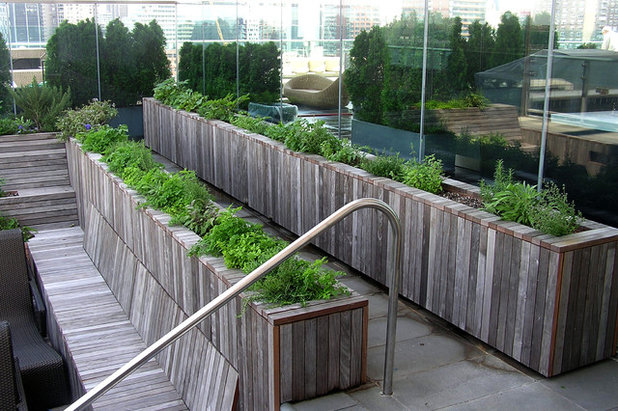
Future Green Studio
As these planters were designed for edible gardening, leaching from the wood was an additional concern. All ipe planters were therefore lined with cedar. Otherwise, marine-grade or pressure-treated wood would suffice for ornamentals.
Rooftop gardens also have the added challenge of weight to contend with. Soil, particularly when wet, is extremely heavy and therefore typically requires a soil mixture made from lighter materials. A company called Rooflite supplied the growing media for this project. Pool Farm served as a test site for a new mixture designed specially for rooftop agriculture.
Rooftop gardening doesn’t need to be governed by limitations and what you can’t do. Understand what has to be in place for your garden to thrive. Everything else can be left to creative license.
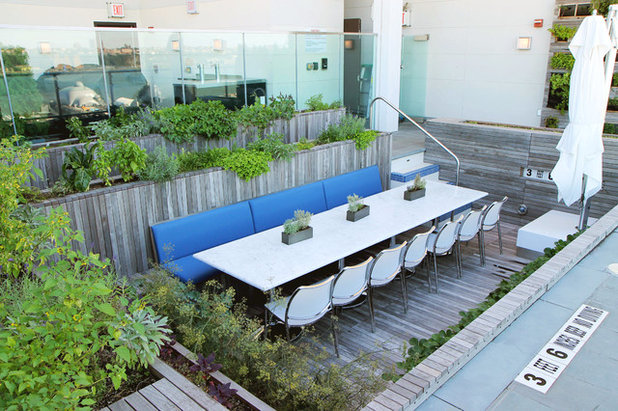
Future Green Studio
4. A productive garden is a beautiful garden. The Pool Farm project shows that not only can you garden and grow your own food no matter where you live, it also reveals that performative and productive landscapes can be just as valuable and beautiful, if not more, as ornamental landscapes.
While we may not all have penthouse vegetable gardens staffed by a full-time forager, many of us have front yards, porches, windowsills or even walls to use. Instead of a lush, green lawn, consider an edible estate. Create planters, urban habitats or even a living wall.
On the civic scale, why not consider urban street orchards in place of street trees; temporary urban farms on post-industrial sites.
Whether in the city, where a windowsill or wall may be the closest thing to a garden; or in the suburbs, where a front lawn has for years defined curb appeal, how can you make your landscape more livable now and sustainable for the future?
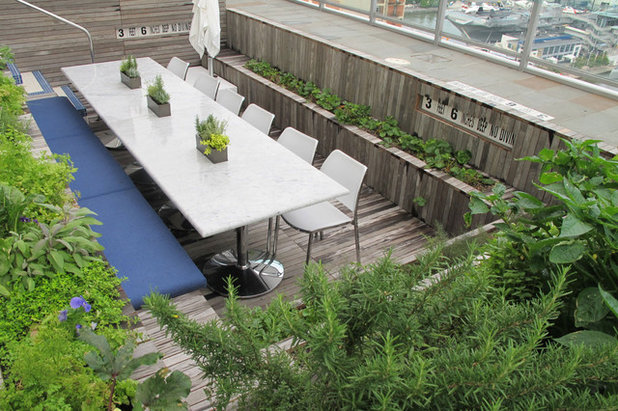
Future Green Studio
Seiter hopes that with projects like Pool Farm, The High Line and Brooklyn Grange, the stigma of what makes a landscape worthwhile and appealing can be re-evaluated, fueling more and more projects that can do more than just visually stimulate — they can work.





